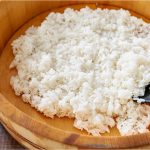Wij spraken met Sushi chef Kitsanin Thanyakulsajjai en vroegen hem tips voor de perfecte sushi rijst. Dit is zijn recept om sushi rijst thuis te maken. Volgens Kit is het belangrijk dat je met de juiste soort rijst werkt en met de juiste azijn. Veel van deze producten zijn in Nederland niet te koop, maar als je toch goede sushi wilt maken, volg dan dit recept (in het engels).
Sushi rijst van Sushi chef Kit
Probeer met de beste Sushi rijst te werken. Bij de toko of Aziatische supermarkt hebben ze al veel betere rijst dan in de supermarkt. In Amsterdam tipt hij Atariya in Buitenveldert. Zij hebben verschillende soorten rijst. Kit schrijft daarover:
Koshihikari – tastes great and is very popular, but doesnt work best for sushi professionally as the rice doesn’t disappear into the sushi and can stand out quite a bit.
Sasanishiki – great for sushi as it doesn’t assert itself too independently but its not something you could buy here.
Akitakomachi – dryer feel and more starches creating a lesser degree of grain separation
Hitomebore – lower water content and easier to handle (more grain separation between fish and rice). Not very assertive.
Nanatsuboshi – similar to hitomebore and sasanishiki, not sold for domestic consumers here in netherlands though
Sushi Rice (in English)
Ingrediënten
- 300 g Sushi rijst verhouding rijst / azijn is 3:1
- 100 ml rijstazijn
- 10 g zout verhouding azijn / zout is 10:1
- 10 g suiker verhoding azijn / suiker is 10:1
Instructies
- With running water fill half up to half a large washing bowl.
- Throw the dry rice in and start washing quite heavily, do not spend more than 5 seconds.
- To wash simply stir clockwise or anti clockwise (right or left handers, also depend where the tap is, just positional).
- Pour out the water and start filling up the bowl with water again, start washing rice again after bowl is half filled, this time with less force and extend washing time to 10 seconds. repeat step 3 about 4 times.
- Drain the rice in a very fine sieve of sorts. let stand for an hour or two.
- Soak rice with water in a rice cooking pot or a usual pot on stove. 1 to 1 ratio. Leave soaking for 20 minutes.
- Start cooking, if you use the pot on the stove try to cook for 15 to 20 minutes depending on the pot and stove, low heat.
- Once cooking is done, take the pot out of the heat source and put a lid on, rest for 10 minutes.
- Have a ready mixture of rice vinegar, salt, and sugar ready. a standard recipe is per 100ml of vinegar use 10 grams of salt and 10 grams of sugar. aim for 3:1 ratio weight of dry rice weight to vinegar.
- Once resting time is up, put cooked rice in a hangiri (open wooden oke, some substitute of any material can work too if it is big enough).
- Scrape off the bottom, this might be already burnt in the pot which is fine, these are broken grains we do not want to use.
- Mix in the vinegar into the rice with a cutting motion. Do not crush grains and do not spend more than 1 minute mixing and cutting.
- use a wet towel to gather lone grains of rice and spead the rice evenly to cool.
- Flip the rice after 1 minute.
- Rest for 1 more minute.
- Transfer into a pot or container, it will be ready to use after 20 more minutes of resting.
Notities
Podcast: Advanced Sushi with Kit
In deze aflevering praten wij met Kit over Sushi, Omakase en zijn nieuwe plannen.
Voor bijzondere ingrediënten werken we samen met Pimentón, dé webshop voor foodies en hobbykoks in de Benelux. Onze recepten linken direct naar hun site.



